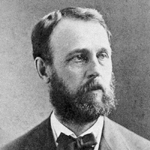
Asaph Hall
Asaph Hall was a Connecticut man, known locally as a skilled carpenter, and known globally as the astronomer who discovered the moons of Mars. Raised on a farm and the oldest of six children, Hall would do anything to make a little money for his family (after the death of his father) and somehow find a way to get educated, too. Never a college graduate, Hall took night lessons and winter courses when opportunities arose, and though he never left school with a degree, he left with something greater: Angeline Stickney, a fellow student who soon came to play the role of Hall’s devoted wife. It was Stickney who pushed Hall to pursue his passion for astronomy, noticing his uncanny mathematical abilities. So, for a weekly salary of $3, Hall began working at the Harvard College Observatory under the supervision of Professor William Cranch Bond while Angeline continued working as a schoolteacher. While colleagues, friends, and family urged him to quit, warning him that his family would starve, Hall “laughed at this,” and explained “my wife and I had made up our minds that we were used to sailing close to the wind, and felt sure we would pull through.” Soon enough, Hall would become an expert computer at the Harvard observatory and fortunately benefited from a hefty raise.
In 1863, Hall moved his family to Washington D.C. to start work at the U.S. Naval Observatory. There, he was director of the observatory and later appointed Professor of Astronomy by President Abraham Lincoln himself (the president and Hall met at least once and shared a thorough conversation on contemporary astronomical developments). Hall stayed at the Naval Observatory for 30 years, making his infamous discovery of Mars’ moons by using the Observatory’s 26-inch refractor telescope--the largest lens in the United States at that time. With a push from Angeline to keep on hunting for “satellites” orbiting the red planet (weather obscured viewing conditions on the banks of the fog-laden Potamac River and made the astronomer himself doubtful), Hall finally spotted the two on August 11 and 17, 1877. He wittily named the moons Phobos and Deimos after the deity Mars’ attendants in Homer’s Iliad. The astronomer made his discovery by giving extra attention to the space near Mars’ surface, which required innovative observing techniques and the will to go against the common knowledge of astronomers and astronomy textbooks of the day that declared Mars had no moons at all. Immediately after Hall announced he had discovered Mars’ moons--a declaration he delayed in order to secure all credit for himself--his colleagues started “seeing” things in the skies, too. Away at the time in New York, Hall’s assistant Holden claimed to have spotted two more moons with Henry Draper, a doctor and amateur astronomer. Simon Newcomb, the first person to whom Hall revealed his discovery, wrote in a New York Times article that Hall wouldn’t have made the discovery without Newcomb’s insight. With reactions like these, it’s not difficult to conclude why Hall wanted to keep his discovery secret for as long as possible and waited for Holden to be out of state when he made his announcement. Hall calculated that the Draper-Holden moons were a mathematical impossibility and later Holden would become a bit of a laughing stock to the astronomical community.
Hall made his discovery using the Naval Observatory’s large telescope but noted that the moons could’ve been viewed much earlier with much smaller instruments. Indeed, as William Sheehan, a current scholar on the planet Mars writes, Hall’s discovery owed much to “his imagination and willingness to doubt conventional wisdom.” And, we’ll add, his loving wife.
Hall never actually signed the Van Vleck Observatory Guestbook; in fact it was his son, also named Asaph Hall and also a noted astronomer, who signed years after his father’s death. Although technically not a signatory, his story is too good not to share!
Further resources:
http://articles.adsabs.harvard.edu/cgi-bin/nph-iarticle_query?bibcode=1908AN....177..127E&db_key=AST&page_ind=0&plate_select=NO&data_type=GIF&type=SCREEN_GIF&classic=YES
http://www.uapress.arizona.edu/onlinebks/MARS/CHAP05.HTM
http://connecticuthistory.org/goshens-asaph-hall-becomes-an-astronomical-success/
http://www.nasa.gov/exploration/whyweexplore/Why_We_27.html
http://www.universetoday.com/88253/finding-phobos-discovery-of-a-martian-moon/
http://www.nndb.com/people/591/000165096/
http://www.jstor.org/stable/1632565?seq=1#page_scan_tab_contents
The Facts
OccupationProfessor of Astronomy and Director of Washington D.C. Naval Observatory
Date & Place of BirthOctober 15, 1829 in Goshen, Connecticut
Date & Place of DeathNovember 22, 1907 in Annapolis, Maryland
Alma MaterMcGrawville, NY (attended), University of Michigan (attended)
Observatory AffiliationHarvard College Observatory, U.S. Naval Observatory